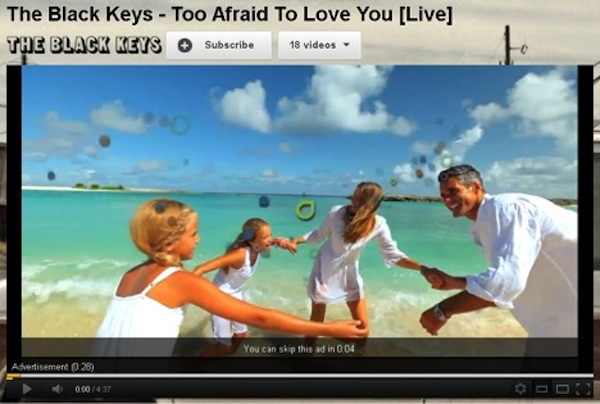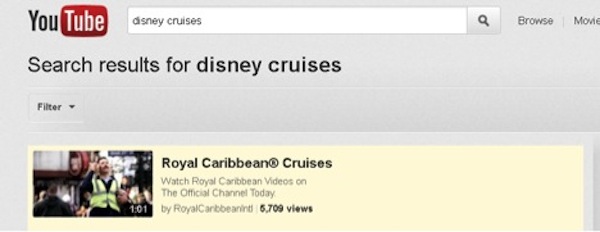YouTube: Your one stop shop for cat videos. Producing video content has become so easy that cats have become famous. But can there really be a viable and advertising source hidden between the adorable clip of the one with the static balloon stuck to his fur and the other one in the top hat playing piano?
With a wide variety of advertising options to suit almost any advertiser’s needs, YouTube has just shown us their serious side, too. Since Google purchased the online media hub (in 2006), video advertising on YouTube has now become as refined as Google AdWords itself.
In inverse proportion to the rising fame of cats, so Google is helping video advertising be more accesible to any business. YouTube has a variety of advertising options available to cater to the requirements of any client, from niche riverfront European tourism to giant American auto brands.
YouTube Homepage Redzone
The most obvious example is homepage advertisement, called YouTube Homepage Redzone. For 24 hours, an advertiser can utilize a large space on the YouTube homepage however they like; keep in mind the main purpose of this ad type is branding, so advertisers should ensure creative is unique and engaging. This is usually in the form of a large banner video ad and mixed media options (watching trailers or clips, interacting with images, games, etc).

The best results for this type of YouTube ad include creative that offers viewer involvement. With such dynamic ads, advertising options are highly customizable: a game or clip specifically relating to the ad that gets the viewer engaged works best.
By far, this is the most expensive advertising option on YouTube (a day will run you about $300,000). Advertisers that appear here are usually global, well-known brands like new movies (see John Carter above), car brands, or national restaurant chains.
TrueView In-Stream
Not to worry, not all advertising options on YouTube will leave your pockets empty. A relatively new form of advertising on YouTube, TrueView In-Stream, has become increasingly popular over the past few months. In-Stream advertising is a pre-roll video spot that appears before a video that the viewer has chosen.

These ads are usually between 30 and 60 seconds, and can be skipped after 5 seconds of viewing. Surprisingly, longer videos tend to work best for In-Stream ads, so trend toward the :60 spot over the :30 spot.
Once the viewer has watched the first 30 seconds of your video, you are charged. So why not opt for more exposure at the same price?
In-Stream ads are cheaper CPCs/CPVs (cost per click, view) averaging about $0.04 each, have view/click traffic data that is up to the hour and provide a 20 percent increase in effectiveness compared to only viewing the ad offline.
In-Stream ads work on the basis of contextual targeting, interest targeting, or demographic targeting. Campaigns must be specific; a demographically targeting campaign combined with topic targeting – even in a niche market – usually yields the best results. You can choose to advertise before videos that match the content of your ad, target users that are logged into YouTube and have the same interests as your ad, or target users that are logged into YouTube that match your demographic.
TrueView In-Search
A more traditional route to take is In-Search advertising (formerly Promoted Videos). TrueView In-Search ads work almost exactly like a text ad in Google Search: a campaign is built by adding and bidding on keywords, and ads have the same length requirements as AdWords.
A thumbnail image is taken from the ad, and the advertiser has the option to choose between four predetermined video freezes.

However, Google have recently introduced customizable thumbnails. With the capability to produce clear, crisp, focused custom images, ‘view rate’ will no doubt improve greatly, especially if advertisers choose an image that is directly related to the ad.
YouTube recommends that you direct your viewer to your brand channel to watch the video, but it’s also possible to watch the video as a separate ad if you don’t have your own brand channel. An added bonus of TrueView In-Search is that a small Call-to-Action Text Overlay box appears over the ad as it runs.
The same fundamental strategies apply to AdWords for Video as they do in AdWords, but since the advertising market is not as saturated on YouTube as it is on Google, bidding on more general terms provides better results. For instance, a regional pizza chain could bid on words like ‘pizza’ and ‘pizza delivery’ with better positions than they could achieve on Google.
Tracking is similar to AdWords as well, but conversions can’t be tracked since the viewer is only watching a video, not clicking through to a site. However, Negative terms will vary, since YouTube is more of a direct news source than Google. The best way to figure out which negatives to add is to closely monitor the campaign in the first few weeks to weed out any odd queries triggering your ad.
Targeting YouTube via the Google Display Network
If you’re completely new to YouTube and just want to get your feet wet, there is a text overlay only option. For AdWords users making the transition, this is the perfect first step – just create a placement campaign and target YouTube.com
Much like the Call-to-Action Text Overlay that comes complementary with the In-Search campaign, a Text Overlay box will appear over contextually targeted videos based on keywords, but instead of your text ad showing over your video, it shows when the query triggers it. Text Overlay ads are all about context. Marketers must think through the videos and text in the ad overlay, as Topic targeting is the driving force behind this ad unit.
The requirements for Text Overlay ads are the same as AdWords, and the destination URL can be a location outside of YouTube, making tracking results as easy as it is in Google. Choose your URL carefully, and take time to think about the strategy. Do you want the same landing page as your AdWords text ads, or do you want something more video-inspired? CTR may be lower with the video options, but marketers can usually make up for it with conversions.
Summary
With such a wide variety of advertising options, YouTube is a serious player in the online advertising world. Adding almost any of these campaigns to your account will almost definitely improve performance, no matter what you’re advertising. And, you know, when you need a break after setting it all up, watch this.


